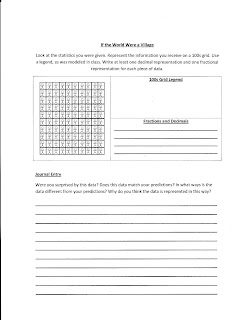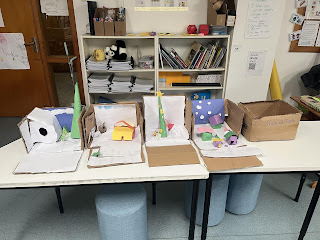Math / Literacy Lesson - If the World Were a Village
At my second practicum, I taught several lessons on fractions and decimals, including the connection between them. At the same time, I was reviewing world geography with the students, for the Social Studies Ancient Civilizations unit. As a result, I created a Math/Literacy Lesson based on the book If the World Were a Village by David Smith. The book asks the readers to suppose that the entire world is contained in a village of 100 people. The resulting lesson had students explore language, math, geography and social justice. Several of the read aloud questions were taken from a lesson plan on the website The Society for Safe & Caring Schools & Communities.
The lesson itself contains several steps/materials. It is designed to be implemented over long morning or afternoon block. When I completed this lesson, I found that the consolidation needed to be completed the following day. In order for students to be mindful and productive participators in the conversation, I gave them 3 minutes to review their journal entry and data before starting the conversation. Having done the consolidation a day after, perhaps some of the rich conversation was lost, however some students spoke to their parents about various issues. Thus, they were better able to express another perspective, and use that information to try and construct their own meaning.
This lesson is representative of Commitment to Students and Student Learning, since all students were respected and taught how to critically think about global issues.
The lesson is contained below the cut
Strand/Topic: Math (Number Sense and Numeration), Language
cut outs of people, tape, map of the world OR smart board with world map and people to drop and drag.
Minds On
Questions to ask - Today we are reading, “If the World were a Village?” what do you think the title means?
What is a village?
Action
Questions to ask - Did any of you have exactly correct predictions?
Did any of you have predictions that were ten or less away from the data in the book? How did the author come up with the numbers for a global village of 100?
The lesson itself contains several steps/materials. It is designed to be implemented over long morning or afternoon block. When I completed this lesson, I found that the consolidation needed to be completed the following day. In order for students to be mindful and productive participators in the conversation, I gave them 3 minutes to review their journal entry and data before starting the conversation. Having done the consolidation a day after, perhaps some of the rich conversation was lost, however some students spoke to their parents about various issues. Thus, they were better able to express another perspective, and use that information to try and construct their own meaning.
This lesson is representative of Commitment to Students and Student Learning, since all students were respected and taught how to critically think about global issues.
The lesson is contained below the cut
Strand/Topic: Math (Number Sense and Numeration), Language
Expectations
Mathematics - Number Sense and Numeration
Mathematics - Number Sense and Numeration
Overall Expectations - read, represent, compare, and order whole numbers to 100, 000, decimal numbers to hundredths, proper and improper fractions and mixed numbers
Specific Expectations - demonstrate an understanding of place value in whole numbers and decimal numbers – represent, compare, and order fractional amounts with like denominators – demonstrate and explain the concept of equivalent fractions, using concrete materials – demonstrate and explain equivalent representations of a decimal number, using concrete materials and drawings
Language – Oral Communication
1. Listen in order to understand and respond appropriately in a variety of situations, for a variety of purposes.
1. Listen in order to understand and respond appropriately in a variety of situations, for a variety of purposes.
1.1 identify a range of purposes for listening in a variety of situations, formal and informal, and set goals related to specific listening tasks
1.2 demonstrate an understanding of appropriate listening behaviour by adapting active listening strategies to suit a range of situations, including work in groups
1.3 identify a variety of listening comprehension strategies and use them appropriately before, during and after listening in order to understand and clarify the meaning of oral texts
Language – Writing
1. Generate, gather and organize ideas and information to write for an intended purpose and audience.
1. Generate, gather and organize ideas and information to write for an intended purpose and audience.
While not directly relating to any of the specific expectations in the social studies curriculum, both strands of Grade 5 Social Studies contain some mapping skills aspects. Given that the nature of the book ‘If the World Were a Village’, students should have some knowledge of world geography. This lesson will reinforce their knowledge of different continents / areas of the world.
- Every decimal can be represented as a fraction
- Every fraction has an equivalent fraction
- Inequalities/inequities/unfair distribution are issues around the world
- Inequalities/inequities/unfair distribution are issues around the world
Critical Consciousness The book supposes that the 6.2 million people in the world were represented as 100 people. Critical consciousness includes issues of the unfair distribution of health, wealth, food/water, housing and technology.
Materials
Minds on handout, Math handout, If the World Were a Village by David J. Smith, , baskets with a box of pencil crayons and 3 data sets, at each table group
cut outs of people, tape, map of the world OR smart board with world map and people to drop and drag.
Minds On
Start with lesson’s big ideas written on the board. Tell students that today you will be reading a book called “If the World Were a Village?” Ask students what they think the meaning of the book’s title is, ask students what a village is. Name several.
Read the introduction on page 7. Tell students that you are handing out a piece of paper that they will have 5 minutes to fill out. Tell students not to worry about having the correct answer, that this is just a guess. The minds on paper, asks students to guess how many people in a village of 100 would:
- Speak English
- Be 12 years of age or younger,
- Have enough food
- Go to school
- Have electricity
Have access to a safe source of water
Read page 8, where the author lists how many people live on each continent.
What is a village?
Action
Ask students to bring their predictions onto the carpet to see if any of their predictions are correct.
Read “If the World Were a Village.” At the end of the book, ask students if they had any correct predictions. Ask students if any of them had predictions that were ten or less numbers away from data.
Ask – How did the author come up with the numbers for a global village of 100? Discuss how many people are living on earth, and how many people one person represents. (62 0000 000, approximately twice the population of Canada)
Tell students that we will now be switching gears, and relating the book to math. Each math pair will get a set of statistics to work with, which can be found in the baskets at each table group. With the statistics, they will need to fill in a 100s grid, using different colours, create a legend. After they create a legend, they will write down each piece of data as a decimal and a fraction. Tell students that equivalent fractions are also okay.
Tell students that they have 15 minutes to complete the math, after they are completed the math activities, they will write a journal entry about their reaction to this data. Tell students that all instructions are on the worksheet. Send students back to the desks in their math pair, and direct them if necessary.
Questions to ask - Did any of you have exactly correct predictions?
Did any of you have predictions that were ten or less away from the data in the book? How did the author come up with the numbers for a global village of 100?
Consolidation
Have students complete the journal entry as homework, if necessary. If the journal writing runs overtime, be sure to have a consolidating discussion on another day. After conversation, collect papers to ensure completion.
Questions to askWhat data set were you using?Did any of the data surprise you? Why?
Why is food/water/technology/housing/wealth distribution so uneven? How could we make it more fair? (Should we make it more fair?)
Next Steps
In the spirit of Changing the World, it would be best to next explore some of Craig Kielburger’s books/picture books and activities in the classroom guide “Take Action: A Guide to Active Citizenship.” Unfortunately, due to lack of time I was unable to pursue this with my practicum class. Hopefully, I will have the chance to teach this lesson in the future and students will be interested in some of these activities.
Below is the 'action' math and language worksheet, for this lesson.
Below is the 'action' math and language worksheet, for this lesson.




Comments
Post a Comment